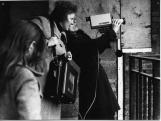1
"If you want to get into the future, get into video." said Richard Lacroix at the 1967 Fusion des Arts conference in Quebec. His declaration came shortly after the introduction of the the Portapak.The Sony Portapak - the first battery-operated, portable video recorder aimed at amateurs - was introduced in 1965 and commercially available by 1967. The technology was relatively crude by today’s standards: images were black and white only, editing was not possible (though artists eventually discovered a way), and, though sold as a portable system, its separate components weighed upwards of fifteen pounds each.
Despite these limitations, it proved a revolutionary technology. Video could be recorded relatively easily, unobtrusively, and inexpensively in comparison to film. Unlike consumer film formats, like Super 8, it could be shared immediately, the image erased and tape reused. It was seen by some as the missing link between non-commercial producers and broadcast television.
Yet, while aimed at the amateur market, it was not inexpensive. It was, in part, the collective action of artists that put the technology into the hands of a probing and curious generation raised in, and critical of, a televisual world. The Portapak quickly captured the imagination of social activists, artists of all disciplines, as well as media educators and critics interested in its potential as a democratizing tool to counter the homogeneity of commercial media.
"Looking back, it was a vibrant time, with no antecedents to fetter creativity, no video art, no video shops, no home video. Original in every respect, the first generation of video creation built the base on which alternative video activity continues today." - Michael Goldberg
Several Vancouver artist societies and initiatives embraced the Portapak. One of the earliest was the informal art collective The Intermedia Society (founded 1967) which was rooted in experimental interdisciplinary art practice and influenced in part by the media theory of Marshall McLuhan and philosophies of Buckminster Fuller. Metro Media (founded 1971) advocated for education and activism through video, with an interest in the emerging community cable system as a dissemination medium. Both groups maintained a pool of video equipment that could be borrowed by individuals and communities who otherwise would not have access to it. Many groups, individuals and institutions directly contributed to the vitality of the early video scene and lay the groundwork for the eventual establishment of an alternative video library.
Sources:
Crista Dahl Media Library & Archive
"Making Video 'In'", Editor Jennifer Abbott, Video In Studios, 2000.
2
Paul Wong: The First Time2013
VIVO Media Arts Centre, 1965 Main Street, Vancouver, British Columbia, Canada
 Credits:
Credits:Interviewer: Kevin Doherty
Cameraperson: Anna MacDonald
Editor: Kevin Doherty
Transcription: Kevin Doherty
4
Peg Campbell: Using the Portapak2013
VIVO Media Arts Centre, 1965 Main Street, Vancouver, British Columbia, Canada
 Credits:
Credits:Interviewer: Kevin Doherty
Technician: Anna MacDonald
Editor: Kevin Doherty
Transcript: Kevin Doherty
5
The Accessible Portapak Manual1976
Vancouver, British Columbia, Canada
 Credits:
Credits:Author: Michael Goldberg
6
The Accessible Portapak Manual: Introduction & Table of Contents1976
Vancouver, British Columbia, Canada
 Credits:
Credits:Author: Michael Goldberg
7
The Accessible Portapak Manual: sample page1976
Vancouver, British Columbia, Canada
 Credits:
Credits:Author: Michael Goldberg
8
"Portable Video In Vancouver": The challenges of access1975
Vancouver, British Columbia, Canada
 Credits:
Credits:Artist: Rick Ward
9
Teaching video skills to the community1984
Video Inn, 261 Powell Street, Vancouver, British Columbia, Canada

